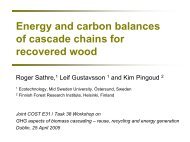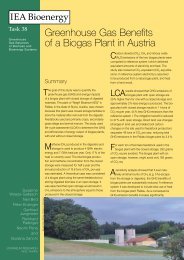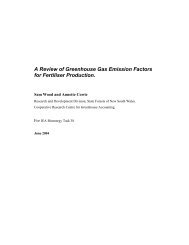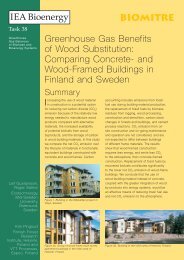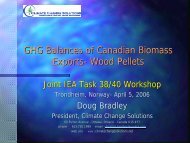Land-Use, Land-Use Change and Forestry - the IEA Bioenergy Task ...
Land-Use, Land-Use Change and Forestry - the IEA Bioenergy Task ...
Land-Use, Land-Use Change and Forestry - the IEA Bioenergy Task ...
Create successful ePaper yourself
Turn your PDF publications into a flip-book with our unique Google optimized e-Paper software.
S.Subak – Addressing COP6 Decisions on Agricultural Soil Carbon 9Addressing COP6 Decisions on Agricultural Soil CarbonAccumulationSusan SubakAmerican Association for <strong>the</strong> Advancement of Science FellowOffice of Atmospheric Programs, U.S. Environmental Protection AgencyABSTRACTThe Kyoto Protocol introduces <strong>the</strong> possibility that changes in carbon stock on agricultural <strong>and</strong> forest l<strong>and</strong><strong>and</strong> soils may be counted against countries’ commitments to reduce <strong>the</strong>ir greenhouse gas emissions.Including activities related to l<strong>and</strong> use change <strong>and</strong> forestry in <strong>the</strong> international climate change agreementmay stimulate new incentives for soil-conservation practices domestically. However, a primary criteria for<strong>the</strong>ir inclusion relates to <strong>the</strong> level of accuracy <strong>and</strong> transparency with which carbon stock changes can beassessed. Parties will also be concerned with <strong>the</strong> wider environmental impact of different sequestrationpractices, <strong>and</strong> <strong>the</strong> impact of offsets on overall emissions targets. This paper examines <strong>the</strong>se issues foragricultural soils, considering recent research in temperate regions. It is argued that incentives for carbonsequestration practices may need to be implemented independently of actual stock changes because farmlevelsoil monitoring would be very costly. Priority should be given to establishing incentives for covercrops <strong>and</strong> to exp<strong>and</strong>ing conservation tillage programs. These activities provide a range of ancillaryenvironmental benefits. In contrast, improvements in biomass yield tend to rely on higher fertilizer inputswith <strong>the</strong>ir related environmental costs. Carbon accumulated through any of <strong>the</strong>se activities is easily lost if <strong>the</strong>practices are discontinued, <strong>and</strong> so assessment procedures are needed that would avoid overestimatingsequestration. Annual accumulation in agricultural soils could be equivalent to about 10% of Annex I carbondioxide emissions, <strong>and</strong> <strong>the</strong>refore options for limiting sink credits from soils should be considered.





